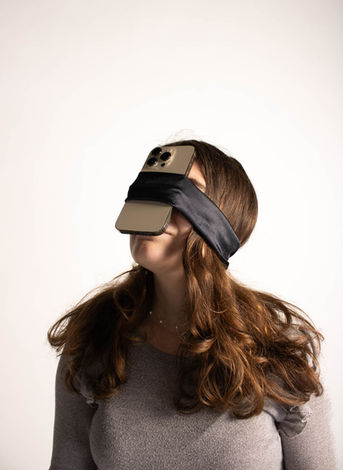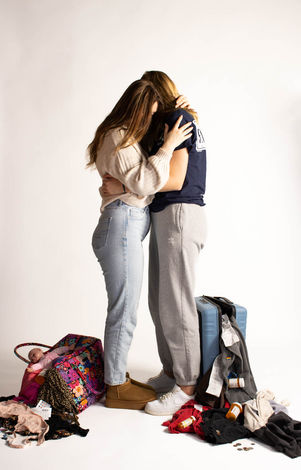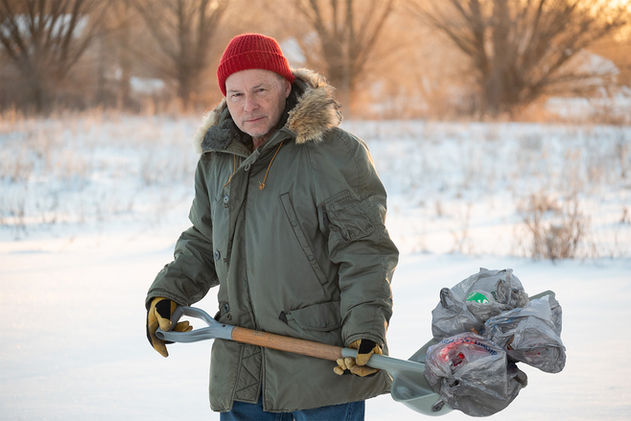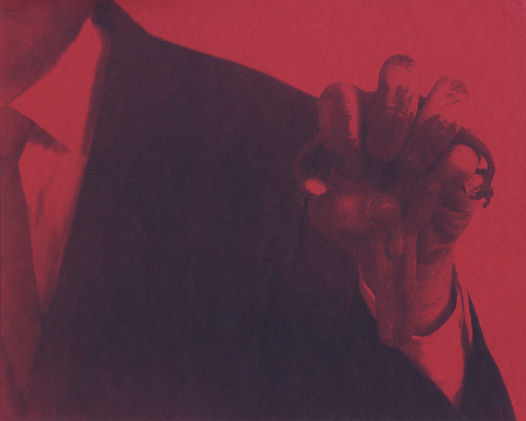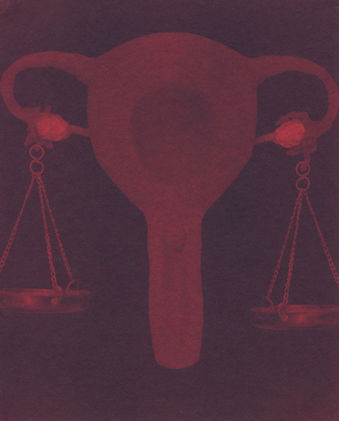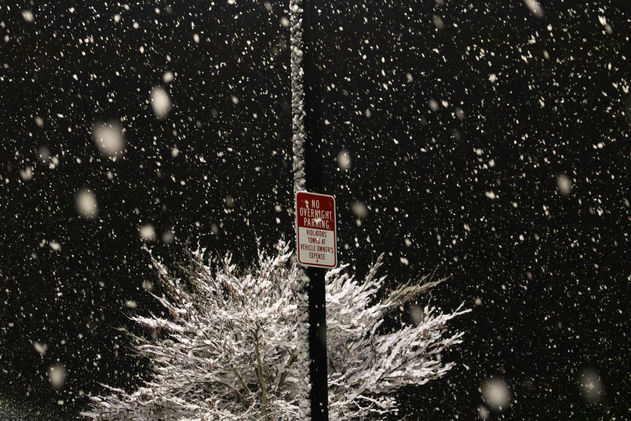Unveiled
An Exhibition by the Spring 2024 Advanced Photography Class
What’s happening under the veil? In today’s society there’s hidden truth present in everything we do. In this exhibition, Southern Illinois University Edwardsville’s advanced photography class unveils these hidden ugly truths. Through the camera we show what’s really going on.
This exhibition was first shown at SIUE's Noise Box gallery in March 2024. The exhibition corresponded with the Society for Photographic Education's national photography conference in St. Louis and the SPE 2024 Members Exhibition in Art and Design West.
Natcha Wongchanglaw
Bio: Natcha Wongchanglaw is a Thailand-born, US-based visual artist who incorporates herself and her experiences to explore the themes of home, culture, community, identity, and the relationship between people and places. Wongchanglaw’s work has been included in national and international exhibitions, including a public art show at The Presidio in San Francisco, LensCulture New York 2022, the RPS International Photography Exhibition 164 in the U.K where she is the IPE award recipient, and the Rockefeller Center’s the Flag Project in New York City. She is also shortlisted for the Portrait of Humanity by the 1854 Media & British Journal of Photography and is included in the Portrait of Humanity Vol 5 book. Her most recent achievement is the Special Encouragement Award from the Nikon Photo Contest 2022-2023. Wongchanglaw earned her master’s degree in digital photography from the School of Visual Arts in New York, and is set to her MFA in Art Studio at Southern Illinois University Edwardsville, focusing on photography and digital media in May 2024.
Website: natchaw.com | Instagram: @nanaka9
Project Statement Rights of Passage:
Freedom isn’t universal. Our treatment is based on nationality, not individuality.
As I've grown older and had the opportunity to travel to different countries, I've realized that the notion that we all enjoy freedom is no longer true. Our identity has come to be determined by our passports because we sometimes are not treated as individuals but as our nation of origin.
Project Statement Diaspora: Global migration, whether driven by choice or external pressures, is a perpetual narrative that captivates me as an artist. Through environmental portraits set against a white backdrop, I symbolize the separation between immigrants and their American home, emphasizing the enduring connection to their heritage. The white backdrop represents the nuanced reality that immigrants may never fully assimilate—a complex facet rather than a deficiency. My project delves into the dualities of belonging and yearning, aiming to provoke contemplation on the concept of home and foster empathy by challenging perceptions.
Maia Huddleston
Bio: Maia K Huddleston is a photographer and digital artist from Mattoon, IL. She received a bachelor of science degree in interactive media from Illinois State University and is currently working toward her Master of Fine Arts in Studio Art at Southern Illinois University Edwardsville. Her fine art serves to increase public access to information and social criticism. Through photography and the moving image, she highlights the personal relationships viewers build with their environments, particularly in places of significant social conflict. By combining imagery with text and interactive media techniques, she helps viewers overcome the cognitive and psychological distance associated with sociopolitical undereducation and common misinformation
Project Statement: The Holy Home is a collection of black and white digital photographs that document the private residences owned by churches for the housing of clergy. Street views and intimate shots of home interiors call attention to the taxation immunity of churches in America and the blurred line between church and state.
Inspired by documentary photographers who create art with moral undertones, this work captures the longstanding relationship between private property and religious institutions, which receive tax breaks because of proclaimed public outreach. The exposure of the parsonage tradition increases social awareness and encourages conversation about the economic power associated with religious tax exemptions.
The exclusionary act of the first amendment guarantees that the United States government pass no law “respecting an establishment of religion.” Despite this initial documentation, several court cases have ruled it constitutional for religious parsonages to remain untaxed. The limits of these tax exemptions currently vary by state. In Illinois, churches are not required to pay property taxes on homes, as long as the occupant lives there as a condition of their occupation. In Missouri, all parsonages are exempt from property tax requirements. Additionally, the church may provide a nontaxable housing allowance for clergy instead of a physical property.
The process of making this work consists of four stages: connection, conversation, capture, and communication. Each photograph is born from an initial connection made between myself and a stranger. Often, this stranger is the priest themself. I reach out to local religious organizations and ask about their parsonages, stressing my interest in the practice. Then, the stranger becomes a friend. I talk at length with each resident about their experiences living in parsonages. I do not use a tape recorder or take notes of any kind. Instead, I dedicate myself to engaging in conversation with the person living in the home. After the conversation, I begin the process of photographing the homes. I’m particularly interested in capturing signs of life or absence of life in the parsonages. These details speak to the inherent human element of the religious tradition. The showing of these works encompasses the communication stage.
By exposing these private spaces, I present the public with an exclusive look into the tax-exempt properties owned by churches. This calls attention to the benefits associated with property ownership by the church, for both clergy, who do not have to report the parsonage as part of their income or assets, and the church itself, who is not required to pay property taxes. When a religious institution acts as a landlord, where does the church end and the home begin?
Lukas Haag
Bio: Lukas Haag is a versatile multimedia artist based in Edwardsville, Illinois, whose creative journey spans the realms of cinematic filmmaking, commercial video production, and photography. With a diverse background in media production and a keen eye for visual storytelling, he has established himself within community as a professional, eager to bring your story to life.
hardlinemediaproduction.com | Instagram: @Hardlinemediaproduction
Project Statement: In "Sweet Deception" I take issue with the false representation of foods and household items as healthful options in commercial ads. By using AI in post-editing to highlight the fundamental lies promoted by these advertisements, I intend to expose the sharp contrast between the reality of sugar-filled foods and the misleading marketing narratives presented in a series of photos.
Unquestionably, sugary snacks and drinks are a common feature of modern diets, and they are frequently marketed as appealing treats that would satisfy and pleasurably tempt consumers. Nevertheless, beneath the glossy exterior of these commercials comes a more sinister reality. The appeal of health and wellness has become a potent marketing weapon in today's consumer society, and food manufacturers frequently take advantage of this trend to position their high-sugar products as healthy choices. Many seemingly healthful goods, such as yogurt and granola bars, are actually loaded with hidden sugars, which increases the risk of obesity, diabetes, and other heart related illnesses.
Household products serve principal functions in our daily lives, their indiscriminate use and disposal can have far-reaching consequences for human health and the environment. The widespread use of antimicrobial agents in household products has raised concerns about the development of antibiotic-resistant bacteria, which could undermine efforts to combat infectious diseases in both humans and animals. It is imperative that consumers educate themselves about the potential risks associated with these products and seek out safer alternatives whenever possible. Each photograph was a stark juxtaposition of beauty and toxicity, highlighting the vibrant colors and enticing packaging of the products alongside their ominous counterparts: monstrous creatures symbolizing the hidden hazards within. Through post-editing, the products are seamlessly integrated into a scene of malevolent figures, creating a visual narrative that is both haunting and thought-provoking.
This series is a reminder of the gap between marketing rhetoric and reality by lifting the veil of commercial product photos with their AI-enhanced parallels. The goal is to enable viewers to critically evaluate marketing claims and make more educated decisions by drawing attention to the disparities between perception and reality. Sweet Deception is a challenge to the sugar-laden and chemical filled products masquerading as effective options. Change starts with you.
maia Moranville
Bio: Maia Moranville, born in 2002, is from Hillsboro, IL. In the fall of 2024, she will graduate from Southern Illinois University Edwardsville (SIUE) with a Bachelor of Fine Arts in Photography and a minor in Art History. Her interest in photography and the arts started when she was younger. It was a way to express herself in a school subject where she felt she could belong and shine. Moranville continued participating in art courses throughout high school and began her undergraduate degree in Bachelor of Fine Arts and a minor in Art History. Her studies at SIUE have allowed her the opportunity to grow and develop her artistic skills across multiple mediums. Moranville's primary medium is photography, but she also enjoys working in metalsmithing and printmaking. The size range of her work varies, but it is usually an 8x11 photograph for digital prints and cyanotype prints. In her time at SIUE, she had work featured in the Annual Student Juried Show and won an award for her cyanotype series called Petals of Society. Moranville's most recent show was the Nosie Box Gallery at Southern Illinois Edwardsville, where part of her Relationships in the 21st Century series was featured in the student gallery. Her work mainly focuses on either Save the Bees or societal standards in America. At the beginning of her career at SIUE, she focused on the theme of Save the Bees, but she is now focused on societal standards in America as her theme throughout the photography she is creating.
Project Statement: Dating in the 21st Century is difficult with the hustle and bustle of everyday life; It is hard to create authentic connections with people, and this leads individuals to use technology and dating apps to fill this void. These apps have great intentions for people to find their romantic partner, which in my case worked, but the mental effect and dopamine one gets from swiping and liking people can create unhealthy addiction with these apps. This concept connects to the rest of the series, which covers relationship labels that our society has made to represent people's connections. The labels, independent or codependent, define a relationship's healthiness due to society creating these social constructs that decide how a relationship is perceived. This series aims to show that impact technology has on relationships in the 21st Century. Viewers are asked to consider their perspectives and connections to the photographs and the impact that technology/labels have had on young adult dating today since the twentieth Century.
Maximilian Lenhart
Bio: Maximilian Lenhart is a German photojournalist based in the St. Louis area. Embracing both analog and digital mediums, his work seeks to explore the interaction between decay and destruction, and how communities cope with developments resulting from change.
Instagram: @mlenhar
Project Statement: Backyard Bomb explores the devastating impact of the Manhattan Project on the St. Louis area and its communities. Beginning in the 1940s, Mallinckrodt Chemical Works produced uranium for the U.S. government to develop atomic bombs. Unknown to the public, parts of the nuclear waste were illegally dropped off at Westlake Landfill, eventually contaminating Coldwater Creek and surrounding soil as a result of rainwater runoff and other weather conditions. To this day, many residents living close by experience severe health issues such as rare cancers or autoimmune diseases and are forced to face elevated radiation levels in their own homes. RECA, the Radiation Exposure Compensation Act, is set to expire in June 2024, and thousands of victims beyond the St. Louis area are fearing to lose government acknowledgment and the opportunity to be financially compensated.
Viewers are confronted with images of a community that has lost its trust in their government authorities and increasingly seen its members fall ill over time. As the debate on renewable energies continues and experts are failing to determine safe locations for long-term nuclear storage, Backyard Bomb serves as a warning about the horrifying consequences of inaction, negligence, and the placement of radioactive material among us.
clair sollenberger
Bio: Clair Sollenberger is an artist based in Edwardsville IlL, but originally from northern IL. She is currently obtaining her Bachelors of Fine Arts, with a concentration in photography, at Southern Illinois University Edwardsville. Sollenberger served as Vice President for the photo club, where she helped bring visiting artists to SIUE and planned events for photographers to do on campus. She has been in the Student Juried show, and in Noise Box gallery, where her work was displayed alongside fellow contenders.
Growing up in northern Illinois, she was an outdoorsy person. Her parents encouraged her to play outside, no matter what season, as much as she could. Her favorite season was winter and she remembers huge blizzards and ice skating every weekend in the winter. As she grew up though, those huge blizzards became smaller and smaller snow storms, and the frozen pond started freezing for shorter amounts of time. Being intune with nature made her realize that something was happening to the planet, and when she got old enough she knew she needed to have a voice in the matter. Photography was an outlet in which she could express these changes in a visual way to make people understand the true impact we are having on the planet. Her work has evolved, starting off focusing on how nature affects humans, but has now switched to how global warming and pollution is affecting everyday life.
Project Statement: Through my series Daily Destruction my work explores how humans are destroying the planet, and how this destruction is reflecting back and affecting us in our everyday lives. Normal tasks are represented through this series, but with a hidden reveal. In each of my pieces I show a small way we are impacting the planet and how those choices are, in turn, impacting us. Whether that's through the surrounding landscapes around my models or something much smaller, such as something they are holding. When everyone thinks about global warming, they should realize the impact it has on everyday life, and not just what is happening to the planet.
These works reflect, not only a personal impact on the environment but also how these choices are affecting human kind. Waste is present in objects that we use without even thinking about it. These can be invisible factors such as chemicals hidden in products, air pollution, and water pollution. They can also be much larger, such as huge industrial factories with multiple smokestacks pushing waste into the surrounding air, or large trash mounds that we may see every day. Through digital photography and post editing processes, such as Adobe Photoshop, I draw attention to these invisible factors in an abrupt way. Looking at this problem brings up a personal reflection and recognition we need to have. How our choices are impacting, not only the world or human kind but how it's impacting and harming our everyday lives
Brooke krankel
Bio: I am a first-generation college student from rural southern Illinois. I received my Bachelor of Science degree in Digital Art and Psychology before starting the MFA in Photography program. As an undergraduate student, I found photography to be a medium in which I could best express the narrative in my mind on how the world could be a better place. I grew up being advised by my mother to let my “freak flag fly,” and I believe this influenced me to perceive the world in a queer way and to reject many of the expectations and traditions of our society.
Website: brookekrankel.com | Instagram: @brooke_stlou
Project Statement: The anguish that women experience in a patriarchal society is the central focus of my work. I investigate developments that have led to harmful traditions and beliefs towards women within culture by examining history, religion, and media. Using my own body as a subject and women that I am close with, I create an informed visual language to confront unacknowledged participation in harmful traditions. My work strategically utilizes gestures, built spaces, and assemblages incorporating symbolism to engage viewers. When working on my concepts for a project, I deliberately align the photo-making process to the themes of the work.
In my series The Birth of Birth Control, I attempt to find answers to the questions of how birth control has been historically imposed on women and currently affects their rights and social equity. I have discovered damning data regarding the gendered pressures and by-products of prescribed birth control, as well as the endurance of child-bearing bodies to use what is accessible to avoid pregnancies that do much bodily harm. I use cyanotypes on red paper for this series as red is a symbol for life, health, war, courage, rage, love, blood, and religious fervor. The blue-purple hue of the cyanotype evokes the look of veins through translucent skin, embodying the life-force of blood and body. This project references the ongoing war being waged on women’s bodies and reproductive rights governed by religious and societal beliefs.
During my research done on reproductive injustice in the series The Birth of Birth Control, I became increasingly aware of the dire impacts of medical practices on women’s bodies in America. We have trusted our health care providers, believing they will provide treatment and protection from illness, harm, or injury. The term palladium has been used to mean anything believed to provide protection or safety, derived from the Greek name Pallas. Medicine has failed women through treating their bodies as alien and other, often to a perilous effect. Examining the relationship between women, illness, and medicine, my series of platinum palladium prints titled Medical Male-Practice evaluates how unwell women are normalized in our culture.
A culturally expected private pain experienced by 50% of the population is menopause, which I am closely witnessing second-hand as my mother is at the age where she is experiencing menopause and has already lost her ability to conceive children. Because I am very close to her, I can see and sense some of the changes in her body, mind, and spirit. To watch her endure the experience without any proper medical or cultural support is very heartbreaking to me as we live in a society that does not value or support older women, which is a fate that could someday be my own. Physicians have knowledge gaps regarding treating women during their reproductive transition, and the series Womenopause aims to represent an aspect of life that is underrepresented in fine art, healthcare, and American culture.
jayden Swayze
Bio: Hello, I'm Jayden Swayze, a 20-year-old Business Administration major specializing in Computer Information Systems. Even though my degree will be in technology and business, my true passion lies in photography. Along with photography I am proficient in multiple instruments, including guitar, bass, drums, piano, and ukulele, I aspire to blend my professional career with my love for photography, envisioning a future where I run a photography business that merges technical expertise with an eye for creativity.
Project Statement:
Mental health is no joke. Society has recently come to accept it more and more. While this is good it makes it much harder for those who struggle with mental health to be seen. We often fade into the shadows. We become a part of the norm and fade into the background. From understanding emotions to the journey for a better life, the steps we take are vital.
ADHD, or attention deficit hyperactivity disorder, is often recognized but rarely understood on a deeper level. Upon receiving my diagnosis, my life took a profound turn. It was a moment of both relief and burden—a realization that a pill could define 'normality.' While some perceive ADHD as mere restlessness or impulsivity, its complexities run far deeper.
Navigating emotions becomes an intricate puzzle, one that demands careful dissection. What appears simple to others is a sea of confusion for me. Motivation, too, presents its own challenges. Transitioning from comfort to activity feels like an uphill battle every day. The simple act of starting the day drains me. The ongoing struggle to remain focused and stay engaged in anything.
These battles I face daily feel invisible to others. Why does something that is so real to me feel so hidden from everyone around me? Asking myself this question sparked the creation of this project. Through a lens, I can capture the world through my own eyes. Each frame is a living part of my life. The struggles and emotions that I fight to understand. Recreating the emotions and struggles I feel through the form of photography and digital manipulation. This project not only has essence, but it is also a cry to be understood.
Shedding light on the struggles living with ADHD, I aim to encourage empathy, understanding, and awareness. Much deeper than the surface-level perceptions of restlessness and impulsivity, there are many experiences, challenges, and triumphs. By sharing my journey, I hope to spark conversations, challenge misconceptions, and push towards a more inclusive and compassionate society. Please take the time to embrace the complexity and diversity of human emotions and experiences. True understanding begins when we become vulnerable. Understanding begins when we are empathetic and embrace acceptance.
sydney williams
Bio: Sydney Williams is a BFA (Bachelor of Fine Arts) Candidate in Photography at Southern Illinois University Edwardsville. She is in her 3rd year and seeks to make work that dissects studies in race within the balck diaspora and gender through the use of the photo manipulation and collaging. Her favorite thing to do is spend time with her sister and watch cat videos.
Instagram: @s.kai_art
Project Statement: My series titled, ‘Black is Joy , confronts the black trauma that I see in the media. Slave narratives, body horror/ mutilation, baby mother dramas, the constant imagery of the undervalued and underappreciated black woman, etc. American news is focused on the incarnation and celebration of black torment. While sometimes this tragic news media gets media coverage that widespread affects my community, it can also be for the most ignorant and avoidable reasons. People are not ready to unpack how we are helping each other to continue to live and thrive in an environment that wants to see us die off one by one. And sometimes, I can’t help but wonder if I will eventually be next. Seeing as this is my potential fate in the world, I aim to show the beauty, liveliness, and greatness that I and many others see. Instead of showing what oppressive powers try to make people and believe and encourage self-hatred, I want to show the black community’s worth and greatness within.
My work seeks to empower the black diaspora while also challenging public opinion through the use of photo manipulation. Through the use of mixing color, textured paper, and cutting into materials, I combine these processes in order to create my desired look that best conveys my message. My color choices are in relation to what the model feels best represents them. I also take inspiration from traditional African wax patterns and textiles. The concepts of black joy, happiness, and associations within a realm of positivity can never seem to coexist or mutually agree with one another. The liveliness, bold, and expressive aspects that are being conveyed can have its voice throughout my photographic process
Hannah Asbeck
Bio: Photography BFA student and artist, Hannah Asbeck has been building her photography skills over the last year and investigating the ways in which it can be combined with other artistic disciplines. Having grown up as the daughter of a minister in the Midwest, her own firsthand experiences play a significant role in her works. Her deep interest in exploring self-portraits as a means of storytelling is clear as she delves into the concept of religious trauma through her combinations of sculptural and photographic works.
Website: artbyasbeck.wixsite.com/artbyasbeck | Instagram: @asbecky_art
Project Statement:
The treatment of women and their bodies within the church, the threat of hell for all mistakes, and the rejection and scrutinization of members who do not behave accordingly are all examples of the patriarchal control of the church at work. The pressure to be perfect and to be accepted helps ensure that members stay in line. It creates an external locus of control and a condemnation of independent thoughts. Women often face the most of this pressure, with most church leaders being male. Sexuality being embraced or talked about is frowned upon, and women’s bodies are often seen as shameful.
There is a common misconception that religious trauma can only come from a horrible physically abusive religious experience, this is not the case. Religious trauma like any trauma, can come from various forms of abuse, not solely sexual or physical. While “shock trauma” like a horrific physical event can cause religious trauma to occur, mental abuse, conditioning, or other destructive long-term experiences also play a role in the development of religious trauma. The psychological impact of this type of ongoing experience can be hard to unpack and understand as one specific event cannot be pinpointed as a cause, and it often requires deprogramming of habits or ideas. The symptoms experienced by those who suffer from religious trauma can include a lack of critical thinking, low self-esteem, perfectionism, depression, anxiety, loneliness, difficulty with connection, shame, and sexual difficulties.
My work seeks to use a combination of sculpture and portraiture to capture the stress and trauma of a toxic church environment. Using both self-portraits and a series of portraits of real women and their stories, I am conveying the manipulation and control endured by women in the church. I am appropriating common Christian iconography like the altar piece to turn the spotlight on both the physical and psychological trauma caused by long-term exposure to an abusive church experience. I have taken themes of baptism, communion, prayer, and anointment, and subverted them to display loss of identity, manipulation, physical abuse, psychological abuse, and verbal abuse. Using these recognizable sacraments in conjunction with the idea of things seen as unclean helps to create tension in the piece. The binaries of clean and dirty help to push the idea that the line between the two is non-existent, and it highlights the internal struggles of dealing with this type of trauma.
I am using wood as is common to that of an altarpiece in a church. I utilize the colors blue, red, and gold as they are all key symbolic colors in religious paintings throughout art history. These connections to antiquity juxtaposed with modern images help to show the long-standing history of abuse of women in churches as well as its current prevalence in our modern society. I am working with a larger formatted scale to envelope the viewer in the images and aid them in feeling the topic's heavy weight. This weight can also be felt in the dark paint color of the altar piece itself. The text tells the stories of real-life women’s experiences in the church. It is important to discuss this trauma as a way of offering a rarely seen view of the church-caused trauma to the public. Many women believe they are experiencing these feelings alone and in displaying them this way I can negate that belief. I use these concepts to explore my own experiences and to represent the experiences of other women as well.




















































































